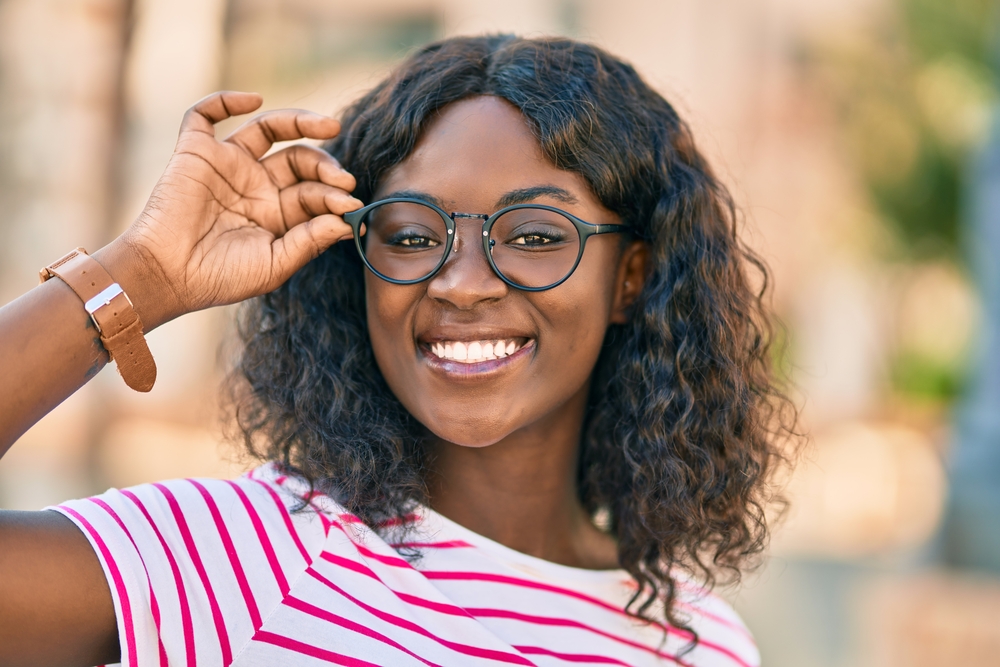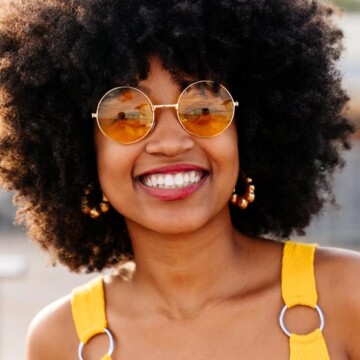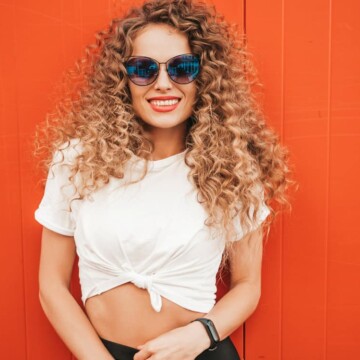
What density wig should I get? Before you take the plunge on a new purchase and risk being stuck with a wig that you hate, take a second to read this article! Today, we’re going to explain everything you’ve ever wanted to know about wig densities.
We’ll break down what wig density means and walk you through how to decide which particular hair density is best suited to you. So sit back, get comfortable, and get ready to become a wig-density expert!
Table of Contents
- 1 What Is Wig Density?
- 2 What Density Wig Should I Get?
- 3 What Is the Best Density for Wigs?
- 4 How to Choose the Right Wig Density
- 5 How to Maintain Your Wig’s Density Over Time
- 5.1 Be Gentle with the Hair Fibers
- 5.2 Cleanse Your Wig the Right Way
- 5.3 Buy and Use the Right Products
- 5.4 Is 150 or 180 Density Better?
- 5.5 Is 150 Density Good for a Wig?
- 5.6 Is 200 Density Good for a Wig?
- 5.7 Is 180 or 250 Density Good for a Wig?
- 5.8 Is 250 Density Good for a Wig?
- 5.9 What Density Wig Looks the Most Natural?
- 5.10 What Is a Low Density Wig?
- 5.11 What Is a High Density Wig?
- 5.12 What Is the Lowest Density Wig?
- 5.13 What Is the Best Density for a Deep Wave Wig?
- 5.14 What Is the Best Density for a Straight Wig?
- 5.15 What Is the Best Density for a Bob Wig?
- 5.16 Related Articles
What Is Wig Density?
For those who aren’t familiar with the term, wig density is a unit of measurement that denotes how thick or full a wig is. The higher the density is, the more hairs the wig has (i.e., hair thickness).
The density of the wig plays a major role in how a wig looks, feels, and can even affect your styling options. For example, the wefts will be more visible on lower-density wigs. That means you won’t be able to wear certain styles or pull the hair up.

What Density Wig Should I Get?
Most wig retailers offer a selection of different wig densities in an effort to meet everyone’s needs. In this section, we’ll walk you through the most common wig densities and explain their benefits and drawbacks.
The ideal wig density depends on various factors, including natural hair density, lifestyle, texture, and age. Here's a wig density chart that will help you choose the right wig density for your needs:
Wig Density Chart
| Wig Density | Density Percentage | Benefits | Drawbacks |
| Extra Light-Density | 60% - 90% | Natural-looking wigs, suitable for elderly or thin hair | Limited styles, not suitable for all |
| Low-Density | 100% - 110% | Lightweight wigs, realistic for fine or thin hair | Less volume, fewer styling options |
| Medium-Density | 120% - 150% | Natural looking wigs, versatile, more styling options | Slightly heavier wigs, may be challenging for beginners |
| High-Density | 160% - 250% | Natural-looking wigs, versatile, more styling options | Slightly heavier wigs may be challenging for beginners |
Extra-Light Hair Density Wigs: 60% - 90%
We'll kick things off with extra light-density wigs. These units have the fewest strands and are usually only suitable for elderly wig-wearers or people with extremely thin hair.
Typically, extra light-density hair is reserved for wig hairlines, where our natural hair is the thinnest. That way, the wig has a natural look and won't appear too wig-like.
Low Hair Density Wigs: 100% - 110%
The second lowest classification of wig densities is low-density wigs. These wigs are extremely lightweight and closely mirror the density of natural human hair.
While anyone can wear a low-density wig, they’ll give you the most realistic-looking results if your hair is naturally fine or thin.

Medium Hair Density Wigs: 120% - 150%
Medium-density wigs are more full and voluminous than low-density wigs but still look natural. Medium-density wigs give you more styling options than both low and high-density wigs and are an excellent middle ground between the two.
Medium-density wigs can be a bit heavy for beginners, although they more than make up for it with plenty of bounce, movement, and versatility.
High Hair Density Wigs: 160% - 250%
High-density wigs give you the most fullness and volume and are perfect for when you want to feel a bit more glam. Due to the number of hair fibers, these wigs can be heavier and less breathable than lower-density wigs. And although high-density wigs will give you a ton of styling options, they can be more challenging to manage.
What Is the Best Density for Wigs?
One reason wigs come in so many options is that everyone’s needs are different. While high-density wigs are great for some, they can easily overwhelm others. However, most people find that medium-density wigs are the most beginner friendly.
Medium-density wigs give you the benefits of both high and low-density wigs without any of the downsides. 130 to 150% density wigs, in particular, tend to be the right combination of natural, versatile, and beginner-friendly.

How to Choose the Right Wig Density
Looking for a bit more help in deciding which wig density to buy? In this section, we’ll take a closer look at how different factors determine which density is right for you.
- Consider your lifestyle - Although it's easy to overlook, your lifestyle can have a dramatic effect on which wig density is right for you. High-density wigs are heavier and less breathable, so these wigs aren’t always suitable for super-active people. But if you go out often and want your hair to have a little extra drama, high-density wigs will help you turn heads.
- Think about the texture - Hair texture can play a significant role in which wig density you should choose. Higher densities look best on long and straight wigs since they already fall on the thinner side. On the other hand, textured hair tends to look fuller than it actually is and requires more maintenance. So if you’re looking to buy a curly or wavy wig, opt for one that’s lower density.
- Your natural hair density - One of the best ways to make your wigs look realistic is to match it to your natural hair. So if your hair is on the fine, thin side, opt for medium or low-density wigs. But if your hair is naturally full and thick, higher-density wigs will look more natural.
- Pick a density that flatters your age - As we get older, our hair naturally starts to thin out. So if you’re older, choose wigs with a lower density. In addition to looking more natural, lower-density wigs are easier to manage and don’t require much manipulation to style.

How to Maintain Your Wig’s Density Over Time
Whether you buy a low, medium, or high-density wig, proper care is essential to maintain that density. The time you take to care for your wig will be reflected in how your unit looks, feels, and lasts. So in this section, we’ll walk you through everything you need to give your wig the TLC it deserves.
Be Gentle with the Hair Fibers
Unlike your real hair, wig fibers don’t grow back. So when caring for and styling your wig, be careful to avoid hair loss and breakage. Whenever possible, comb your wig with a wide-tooth comb, and always detangle your wig before you style it.
You should also avoid heat styling whenever possible and, instead, opt for more gentle styling methods like roller sets, braid outs, and sock curls.

Cleanse Your Wig the Right Way
Washing and drying your wig is essential for your health, as well as the health of your unit. Incorrectly washing your wig will ruin your unit and put your natural hair at risk.
Unwashed wigs are the perfect breeding ground for fungus and bacteria and can exacerbate pre-existing scalp issues. So after every seven to ten wears, add some shampoo to a bowl of cool water, and let your wig soak for around 20 minutes.
Then, rinse well and follow up with a wig-safe conditioner. Gently detangle the unit from the ends up before rinsing well with cool water.
Be careful not to rub, twist, or agitate the wig while wet, or it may lead to breakage and hair loss. Once your wig is clean, place it on a wig stand and allow it to air dry overnight.

Buy and Use the Right Products
When it comes to caring for your wigs, the products you use can be incredibly helpful. Products that contain harsh ingredients, like sulfates, alcohols, and parabens, can damage your wig fibers and cause breakage.
They can also lead to increased knots and tangles that ruin your hairdo and make styling your wig a nightmare. So make sure that you’re using the right products for your wigs.
Though many regular products are acceptable for human hair wigs, synthetic fibers have completely different needs. So, if your wig is synthetic, invest in synthetic wig haircare products.
Is 150 or 180 Density Better?
There isn't a definitive answer on whether 150 or 180 density is better, as the ideal wig density depends on personal preferences and individual needs. A 150-density wig falls within the medium-density range (120%-150%), which is considered natural-looking, versatile, and beginner-friendly.
On the other hand, a 180-density wig is within the high-density range (160%-250%), offering more fullness and volume, but these wigs may be heavier and less breathable. When choosing between the two densities, you should consider your lifestyle, natural hair density, and personal preferences.
Is 150 Density Good for a Wig?
A 150% density is considered good for a wig. It falls within the medium-density range (120%-150%), which offers a natural look, versatility, and more styling options.
Medium-density wigs are generally an excellent middle ground between low and high-density wigs and are often beginner-friendly, making them a popular choice for many people.
Is 200 Density Good for a Wig?
A 200% density wig falls within the high-density range (160%-250%). High-density wigs offer more fullness, volume, and a glamorous look, making them ideal for those who want to make a statement. These wigs also provide many styling options.
However, high-density wigs can be heavier, less breathable, and more challenging to manage than lower-density wigs. Whether a 200% density is good for you depends on your preferences, lifestyle, and desired look.
Is 180 or 250 Density Good for a Wig?
180% and 250% density wigs fall within the high-density range (160%-250%). High-density wigs offer more fullness and volume, along with many styling options. However, these wigs can be heavier, less breathable, and more challenging to manage compared to lower-density wigs.
Whether 180% or 250% density is good for a wig depends on your personal preferences, lifestyle, and desired look. If you prefer wigs with slightly less volume and weight, 180% density might be more suitable. On the other hand, if you desire a full and bold look, a 250% density wig could be a better choice.
Is 250 Density Good for a Wig?
A 250% density wig falls within the high-density range (160%-250%). High-density wigs are voluminous and thick, making them ideal for those who want to make a statement.
High-density wigs also provide many styling options. However, these wigs can be heavier, less breathable, and more challenging to manage compared to lower-density wigs. Whether a 250% density is good for a wig depends on your desired look and preferences.

What Density Wig Looks the Most Natural?
Generally, a medium-density wig looks the most natural as it closely resembles natural hair density. Medium-density wigs has around 120-150% hair density, and it's the most commonly used hair density for wigs. It is thick enough to look voluminous and full but not so thick that the wigs looks fake or heavy on the head.
What Is a Low Density Wig?
A low-density wig has less hair than a medium-density wig. The density of a low-density wig typically ranges from 100-110%. This density is ideal for those who want a more natural and lightweight wig that mimics the look of fine or thin hair. Low-density wigs allow for a more natural and realistic hairline.
What Is a High Density Wig?
The density of a high-density wig typically ranges from 160-250%, making it a good option for those who want a dramatic and bold look. High density wigs are often used in the entertainment industry for performers and models who need to stand out on stage or on camera. Remember, high-density wigs may not always look natural.
What Is the Lowest Density Wig?
The lowest-density wigs are typically around 60% or less hair density. This density is ideal for those who want a wig that looks extremely lightweight. It provides a subtle and realistic hairline, perfect for those who have very fine or thin hair. Wigs with such a low density will not be best for thick or coarse hair.
What Is the Best Density for a Deep Wave Wig?
The best density for a deep wave wig or any curly hair wig is typically around 120-150%. This wig density allows for the curls to be more defined and full, creating a natural and voluminous look. Wigs with a lower density may cause the curls to look limp and lifeless, while a higher density wigs may create an unnatural appearance.
What Is the Best Density for a Straight Wig?
For a straight wig, a 120-130% density is recommended to achieve a natural appearance. This hair density provides enough fullness and volume to mimic the look of natural hair without appearing too heavy or over the top. Lower density wigs may look too thin or flat, while a higher density wigs may look artificial.
What Is the Best Density for a Bob Wig?
For a bob wig, the ideal hair density depends on the length and style of the bob. For shorter bobs, a higher density of around 130-150% can provide a fuller look. However, for longer bobs, a lower wig density of around 100-120% is recommended to create a more natural appearance. It's also important to consider personal preferences and natural hair density.
- What Does Wig Density Mean?
- What Does 180 Density Wig Mean?
- Is 150 Density Good for a Wig?
- What Is a Melted Hairline Wig?
Now that you've learned a little more about wig density, you should feel well-equipped to find the right one for you. As a reminder, stick with wig densities that are on the lower end of the spectrum for a softer, more natural look.
If you’re after big, bold hair with plenty of personality, opt for wigs with higher hair densities. We hope the information we’ve gone over today has been helpful to you, and we wish you the best with your hair!




